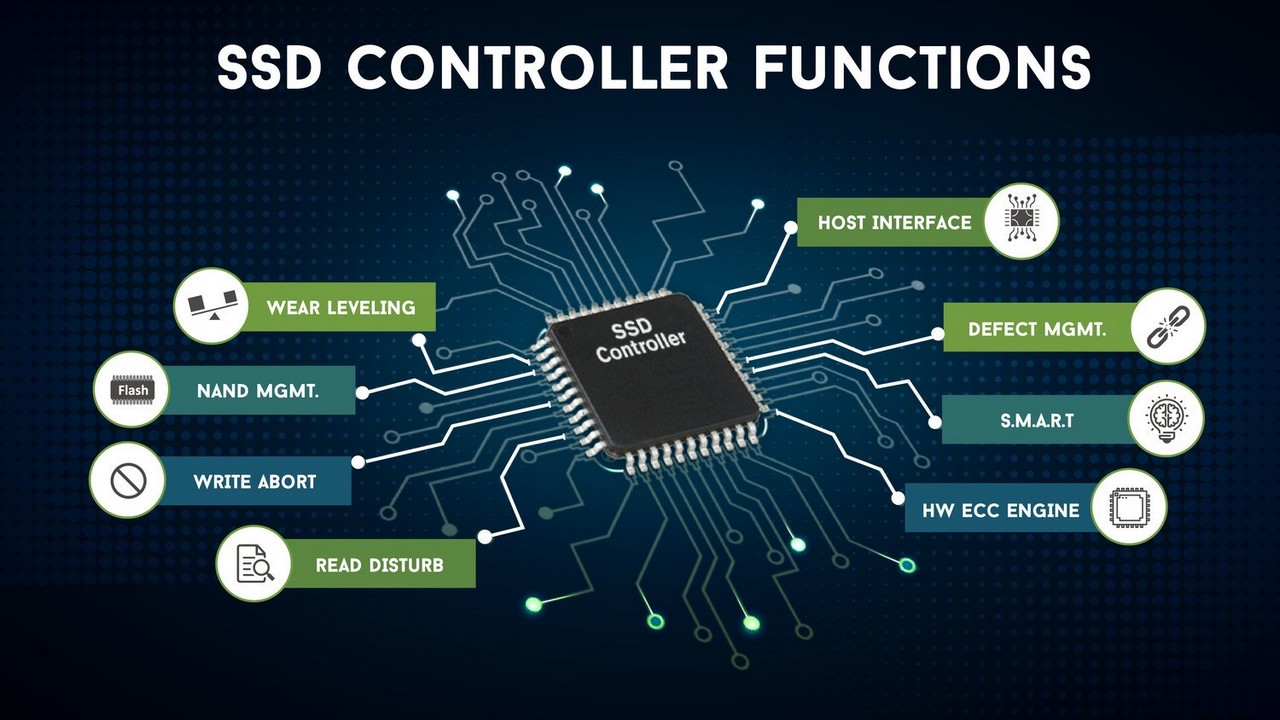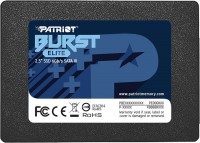Which SSD controller is better: Phison, Silicon Motion, InnoGrit, Maxio?

SATA 3 controllers
The Phison S11 is the oldest SSD controller in widespread use today. It has only one ARM architecture core and cannot work with an external RAM buffer chip. Therefore, the IOPS indicator (the number of input-output operations per second) does not exceed 50K. But it has a small integrated buffer, which saves on the cost of SSD. The volume of the virtual SLC-array is only 1 - 4 GB, depending on the size of the SSD. It can only work with TLC memory, and the maximum SSD capacity is limited to 1 TB.
Maxio MAS0902A is a direct replacement for the aforementioned Phison S11 from Maxiotek (formerly called JMicron). Also very cheap, but already trained to work with more modern QLC memory, so that the maximum drive capacity can reach 2 TB. Often replaces older controllers in 2 terabyte SSD models, such as the Patriot P210.
 |
| Smart controller slows down the wear of memory cells. |
Silicon Motion SM2259XT is perhaps the best SATA 3 controller that supports both TLC and QLC, capable of delivering up to 100 thousand IOPS. The XT index means the presence of a built-in buffer RAM. And with an external DDR3L buffer, a similar controller without the XT suffix can work, but it costs more. Unlike Phison and Maxio, Silicon Motion controllers are built on an alternative RISC processor architecture.

The Patriot Burst Elite is one of the most affordable 1TB SSDs available. It is made in the classic 2.5-inch format, which makes it suitable not only for building new PCs, but also for upgrading old ones. Fortunately, the SATA 3 (6 Gbps) interface is backwards compatible with SATA 2 (3 Gbps) and even SATA 1 (1.5 Gbps). The Silicon Motion SM2259XT controller heats up very little, however, Patriot engineers did not stint on a metal case. Sequential read and write speeds are claimed to be 450 and 320 MB/s, but this is true only for smaller volumes. Terabyte gives out more than 500 MB / s, respectively. The rewrite resource is 400 TB, which is confirmed by a 3-year warranty.
M.2 PCIe 3.0 Controllers
The Phison E13T is a popular NVMe controller that delivers line speeds up to about 2000MB/s and random speeds up to 200K IOPS. This, of course, is far from the limit of the PCIe 3.0 bus, not to mention 4.0. But still four and two times better than the SATA 3 SSD. Traditionally for Phison controllers, the volume of the virtual SLC array is fixed. Calculated using the formula 1 GB for every 64 GB of storage capacity. That is, a terabyte SSD will quickly write 16 GB of data. After that, the speed will drop to about 300 MB / s, which is the actual speed of the flash memory used.
Silicon Motion SM2263XT is Phison E13T's main competitor. Many SSD models, such as the Patriot P300 and P310, interleave these controllers, depending on the flash memory used: Kioxia or Micron. It differs in the SLC-array algorithm: the first third of the free disk space is written quickly - approximately 2000 MB / s. The second third, the speed is reduced to 300 MB / s, and the last third - to 150 MB / s. In the case of an almost empty SSD, this is a plus, while for an almost completely clogged one, it is a minus.
Patriot P310 is an updated version of one of the most popular terabyte M.2 NVMe drives. It has become even cheaper, and a function has appeared to automatically transfer worn-out memory cells to a hidden area. 64 GB of space is reserved specifically for this. Therefore, now you do not have to worry about filling the disk to the fullest. The controller can be Phison E13T or Silicon Motion SM2259XT. In any case, smart TRIM and SmartECC algorithms renew the performance of freed memory cells on the fly and prevent write errors. Delivers linear read and write speeds of 2100 and 1800 MB / s, and random access - up to 280K IOPS. The guaranteed overwrite resource is 480 TB.
M.2 PCIe 4.0 controllers
Silicon Motion SM2267 is the most affordable progressive PCIe 4.0 controller. Only slightly faster than PCIe 3.0's peak speed of 3800 versus 3500 MB/s. Which, however, is not surprising, because in fact it is an old SM2262 controller converted for PCIe 4.0. But in addition to desktop PCs and laptops, it is also compatible with the PlayStation 5 game console, which requires a strictly PCIe 4.0 SSD.
InnoGrit IG5220 - despite the youth of InnoGrit, it is faster and at the same time colder than the aforementioned SM2267. Does not need a separate buffer RAM chip. Writes large files at speeds up to 5000 MB / s, which was previously only possible with the more expensive Phison E16, which was used, for example, in the Partiot Viper VP4100.
 |
| Sequential read speed, MB/s. |
The Phison E18 is one of the two fastest PCIe 4.0 controllers for SSDs (although the first PCIe 5.0 drives are just around the corner). It has three ARM Cortex R5 cores, which results in 7000 MB / s and a whole million IOPS. But it heats up more than any other SSD controller, which forces you to use a large passive radiator or even a small fan.
InnoGrit IG5236 is the fastest SSD controller, better known by the codename Rainier. It delivers up to 7400 MB / s of linear reading, but is inferior to the aforementioned Phison E18 in terms of IOPS - only 750K. Most often used in conjunction with Micron's advanced 176-layer flash memory (although chips with 200+ layers are already being prepared). It heats up weaker than E18, which makes it possible to get by with a thin graphene radiator. It is the basis for, for example, the Patriot Viper VP4300 drive.

Patriot P400 is a relatively inexpensive terabyte SSD with a progressive PCIe 4.0 bus. Suitable for gaming desktop PCs, thin ultrabooks and PlayStation 5. Thanks to the InnoGrit IG5220 controller, it outperforms even more expensive Silicon Motion SM2267 drives. And even less heated, although Patriot engineers still equipped the P400 with a thin graphene heatsink. The larger radiator that comes with the motherboard can be glued directly on top. Speed indicators are declared 5000 and 4800 MB / s for reading and writing, respectively, and IOPS indicators - up to 620K. The rewrite resource is 800 TB, which is twice the low-cost SATA 3 and PCIe 3.0 SSDs.
Articles, reviews, useful tips
All materials
















